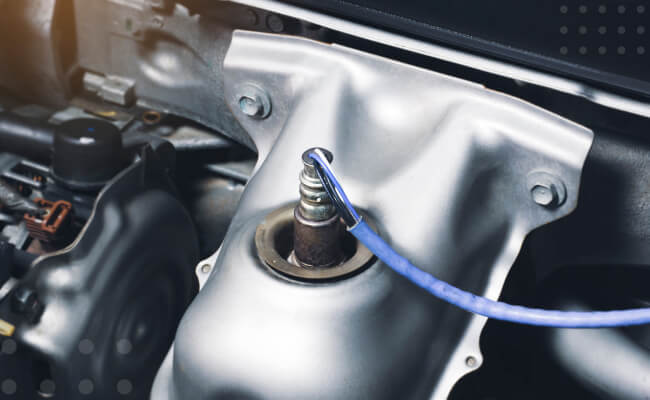| COMPONENT LOCATION |

| GENERAL DESCRIPTION |
The rear heated oxygen sensor is mounted on the rear side of the Catalytic Converter (warm-up catalytic converter) or in the rear exhaust pipe, which is able to detect catalyst efficiency. The rear heated oxygen sensor (HO2S) produces a voltage between 0V and 1V. This rear heated oxygen sensor is used to estimate the oxygen storage capability. If a catalyst has good conversion properties, the oxygen fluctuations are smoothed by the oxygen storage capacity of the catalyst. If the conversion provided by the catalyst is low due to aging, poisoning or misfiring, then the oxygen fluctuations are similar to signals from the front oxygen sensor.
| DTC DESCRIPTION |
Checking output signals from HO2S under detecting condition, if an output signal is below specified value for more than predeterminate time, ECM sets P0137.
| DTC DETECTING CONDITION |
| Item | Detecting Condition | Possible Cause | ||||||||||
| DTC Strategy |
|
| ||||||||||
| Enable Conditions |
| |||||||||||
| Threshold value |
| |||||||||||
| Diagnosis Time |
| |||||||||||
| MIL On Condition |
|
| SPECIFICATION |
| A/F Ratio (λ) | Output Voltage (V) |
| RICH | Min. 0.8 |
| LEAN | Max. 0.1 |
| DIAGNOSTIC CIRCUIT DIAGRAM |

| SIGNAL WAVEFORM & DATA |



Fig.1) Normal graph of upstream HO2S and downstream HO2S at idle.
Fig.2) Normal waveforms of upstream HO2S(the upper) and downstream HO2S(the lower) (chassis ground used)
Fig.3) Normal waveforms of upstream HO2S(the upper) and downstream HO2S(the lower) (sensor ground used)
After warming-up, if accelerator pedal is released suddenly around 4000rpm, the HO2S signal reading will be lower than 200mV resulting from Fuel cut-off for the moment. Conversely, if suddenly accelerator pedal is depressed, HO2S signal reading will be around 0.6V ~1.0V. At idle, Normally HO2S signal will switch from lean to rich with 3 Hz. And as racing, Its frequency rises.
| MONITOR GDS DATA |
| 1. | Connect GDS to Data Link Connector(DLC). |
| 2. | IG “ON”. |
| 3. | Select “DTC” button, and then Press “DTC Status” to check DTC’s information from the DTCs menu. |
| 4. | Read “DTC Status” parameter.
|
| 5. | Is parameter displayed “Present fault”?
|
| TERMINAL AND CONNECTOR INSPECTION |
| 1. | Many malfunctions in the electrical system are caused by poor harness and terminals. Faults can also be caused by interference from other electrical systems, and mechanical or chemical damage. |
| 2. | Thoroughly check connectors for looseness, poor connection, bending, corrosion, contamination, deterioration, or damage. |
| 3. | Has a problem been found?
|
| SIGNAL CIRCUIT INSPECTION |
| ■ Check voltage |
| 1. | IG “OFF” and disconnect HO2S(B1/S2) connector. |
| 2. | IG “ON”. |
| 3. | Measure voltage between signal terminal of HO2S(B1/S2) harness connector and chassis ground.
|
| 4. | Is the measured voltage within specification ?
|
| COMPONENT INSPECTION |
| ■ Check the Signal waveform of HO2S |
| 1. | IG “OFF” and connect HO2S connector. |
| 2. | Engine start. |
| 3. | After warming-up, monitor signal waveform of HO2S with GDS.
Fig.1) Normal waveforms of upstream HO2S(the upper) and downstream HO2S(the lower) (chassis ground used) Fig.2) Normal waveforms of upstream HO2S(the upper) and downstream HO2S(the lower) (sensor ground used) |
| 4. | Is the sensor switching properly?
|
| ■ Check HO2S |
| 1. | IG “OFF” and disconnect HO2S connector. |
| 2. | Check that the HO2S is securely installed. |
| 3. | Check the HO2S for contamination or damage |
| 4. | Is the sensor normal?
|










Comments are closed